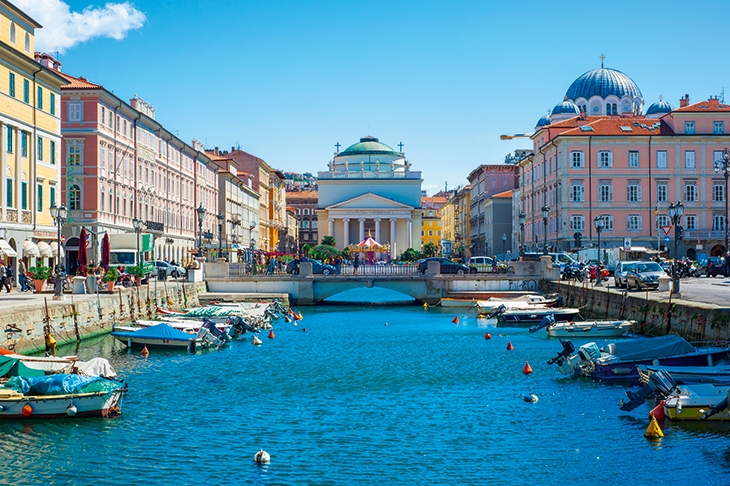‘Welcome to the free territory of Trieste,’ reads the sign in the shop window. ‘US and UK come back!’ For me, this is the sort of thing that makes Trieste such a beguiling place. Sixty-four years since those British and American troops departed and handed this disputed seaport back to Italy, it still feels like a no-man’s-land, stranded between the Slav and Latin worlds.
Jan Morris, the queen of travel writers, called Trieste the capital of nowhere, and I needed to read only the first few pages of her bewitching book Trieste and the Meaning of Nowhere to know I’d love it here. ‘The last breath of civilisation expires on this coast where barbarism starts,’ wrote Chateaubriand, in 1806. Of course it’s considered rather rude to call people barbarians nowadays, but I know exactly what he means. Despite its elegant architecture there’s something untamed about Trieste — the limestone cliffs that tower over it, the fierce wind which lashes the promenade. It’s on the fault line between Catholic and Orthodox, a frontier between West and East.
But the main thing that makes Trieste so thrilling is that unlike Venice (two hours west of here by car or train), it’s almost entirely free of tourists. It has no must-see sights and it always used to be a nuisance to get to. Now that you can fly here with Ryanair a few sightseers are drifting in, but they’re generally independent travellers, keen to spend a few days in an unspoilt city that’s still undiscovered by big tour groups. What those coach parties and cruise ships are missing is an ornate, compact port full of lively bars and homely restaurants, in a spectacular location on a narrow strip of land between wild uplands and a restless sea. As you stroll along its grand old avenues, curiously bereft of traffic, you wonder: how did Trieste end up like this — and why can’t other cities be this way?
The Triestini are proud of their mongrel heritage — Italian, Austrian, Slovenian — and as befits a place with such a hybrid population, Trieste has a complicated past. The Romans were here once, but after they left it became a backwater. In 1382 the Habsburgs incorporated it into their growing empire, but not much happened until 1719, when they opened it up to foreign trade. All sorts of merchants flooded in, Jews, Greeks, Serbs, Croats, and by the 19th century it was one of Europe’s busiest ports, Austria’s gateway to the sea. It also attracted a steady stream of artists and eccentrics. James Joyce spent a decade here before the first world war, writing Ulysses and Exiles while teaching at the Berlitz language school. Freud came to study the sex life of eels.
Trieste’s Italian nationalists always yearned for unification with Italy, and in 1918, when the Habsburg Empire fell apart, their wish was granted. Yet having wrestled Trieste away from Austria at long last, they didn’t really know what to do with it. Italy had lots of other ports in far more useful places, and so the city slowly atrophied. Mussolini put up some bombastic buildings, but these were mainly just for show. In 1943 the Nazis marched in and slaughtered the city’s age-old Jewish population. In 1945 the Yugoslavs drove the Nazis out and ruled the city for six weeks. Then the Western Allies took over and restored order (hence that sign in the shop window). Finally, in 1954, they returned Trieste to Italy. It’s been Italian ever since.
Yet the Trieste you see today is very different from the city Jan Morris fell in love with when she came here as a British soldier, as part of that peaceful occupation. When I first passed through here in the early 1980s on my way to Yugoslavia, it was hemmed in by the Iron Curtain, at the dead end of a one-way street. Only when the Cold War ended did it become a crossroads again. Istria, its historic hinterland now belongs to Slovenia, but the Italianate ports along that shoreline are an easy ferry ride away.
A hundred years since the Austrians fled, Trieste is still haunted by the ghosts of Habsburgs past, and it’s this strange melange of Latinate, Slavonic and Teutonic that gives the city its distinctive flavour. Its cafés are an odd mix of espresso bar and Kaffeehaus; its loveliest landmark, the Castello di Miramare, was built by Maximilian, kid brother of the Austrian Kaiser Franz Joseph. Wandering its robust boulevards, you could almost be back in Vienna. And then you turn a corner, and find yourself staring out to sea.

I stayed at the Savoia Excelsior Palace, a monument to Austrian hubris. When it opened in 1911, it was marketed as ‘the most luxurious hotel in the Austro-Hungarian Empire’. Today the house style is friendly and informal: a grand hotel built for aristocrats has become a pleasant stopover for business travellers and weekenders. It’s a sign of how Trieste has changed.
With its shrunken population (smaller than a hundred years ago) and lots of big empty buildings, Trieste has become a city of museums. I counted 22, two of which are among my favourite museums in the world. Both commemorate Triestini: one who spent a lifetime here, the other just a week.
The Museo Revoltella is an art gallery in the flamboyant home of Pasquale Revoltella, a wealthy philanthropist who left his house and its contents to his home town. But it’s the Museo di Storia ed Arte which sums up the enigmatic magic of Trieste. An archaeological museum in the shadow of the ancient cathedral, it’s dedicated to Johann Winckelmann, the father of modern archaeology, who was waiting here for a ship to Rome when he was killed by a young man he’d befriended. Two hundred and fifty years since he died, no one really knows why. In the garden behind the museum there’s a cenotaph in his honour: it felt like a scene from a film noir, an unsolved murder mystery. As I retraced my steps to Trieste’s tiny airport, to catch my Ryanair flight back to Stansted, I was already planning my return.






Comments